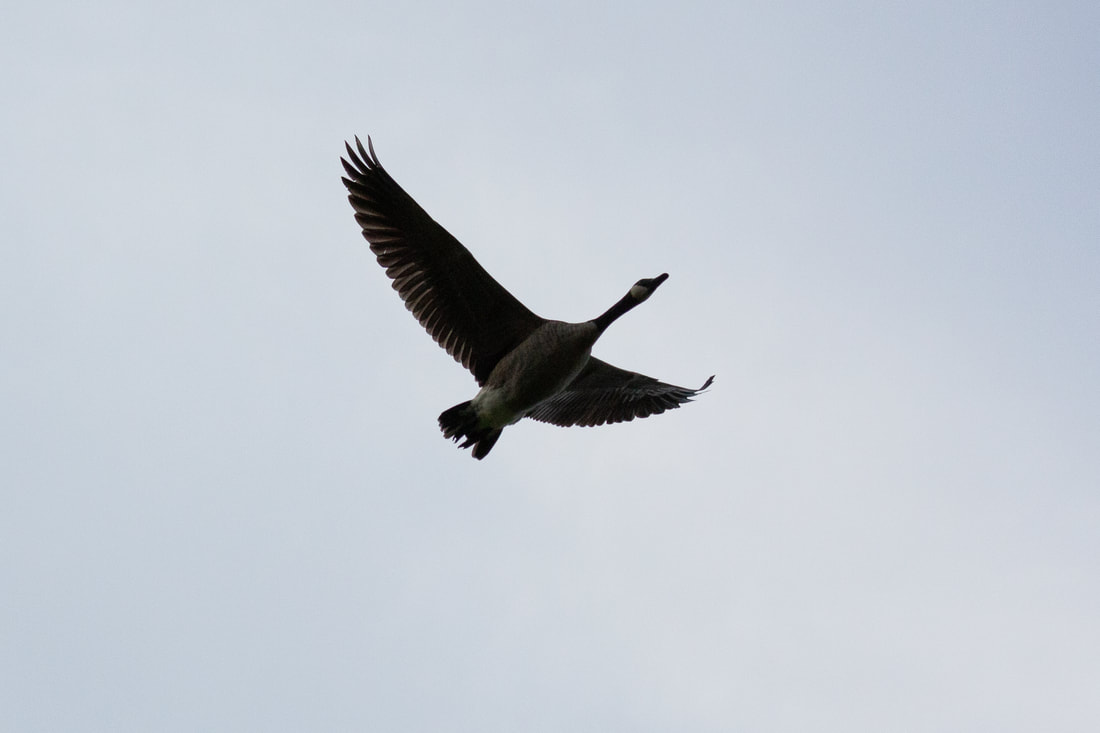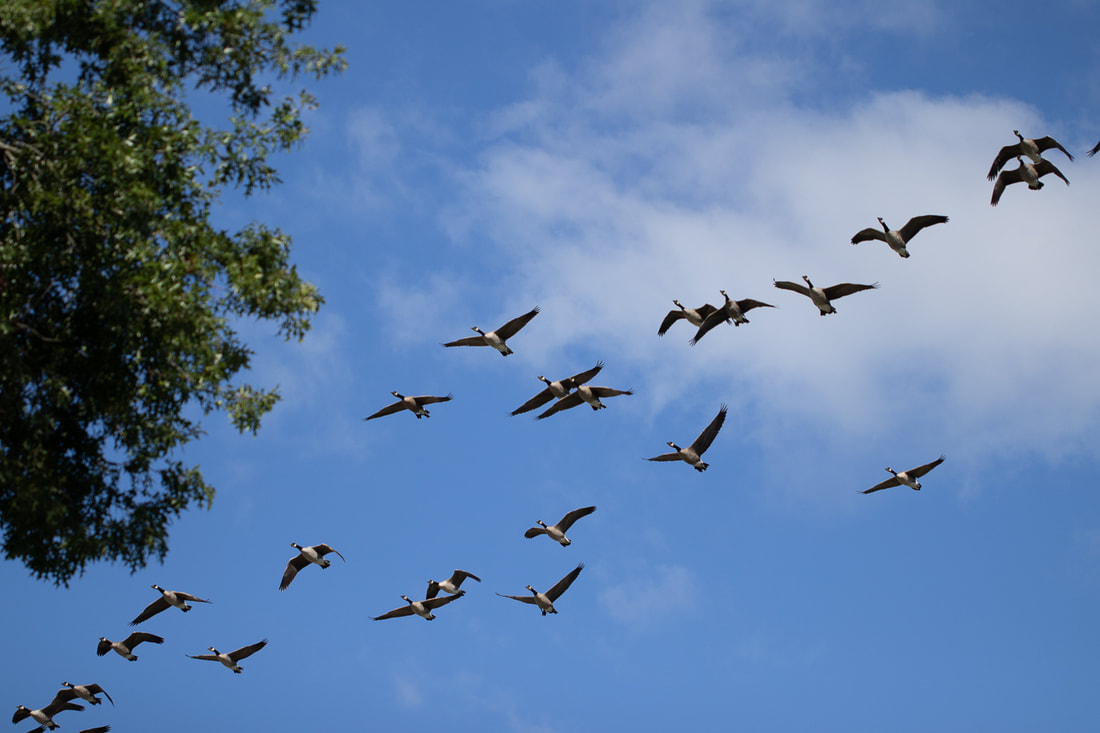|
I have never given Canada geese any thought. At best I've looked upon them as an obstacle when spending time near ponds, their hisses and honks encouraging me to take a different path. But all of that changed at the end of August when I got to observe them in a new way. August 25th was the first day I really noticed them. The evening of the 24th I heard a lot of geese calling, then again the morning of the 25th. I watched as they flew over filling the sky. Never have I ever seen so many geese in one place. Hundreds flew from the west, over our house, to land in the wetlands in the valley below. Every day and every evening I'd hear their calls, in just a few days they had a pretty set routine. 7am - wake up in the wetland valley, rise up with the fog, fly to the west (I jokingly imagine they're going out to breakfast, but maybe). The first group would start about 7am but they'd fly over until about 8:30, all in their family "V"s . 9:30am - return to the valley. Again the family "V"s would fly from 9:30 until about 10:30. 7:30pm - leave the wetlands and fly to the west again (going out to dinner? hah). 8:30pm - return to the valley for the evening, whiffling just past the big maple. So an interesting thing Canada geese do is an action called whiffling. This is when a goose is flying along, then suddenly it seemingly falls out of the air. Sometimes it looks like a barrel roll, sometimes a free-fall. When they do this, the air tension in their wings is released creating a sound - similar to shaking out a towel, a heavy wooshf sound. Why they do this no one is completely sure but it does a few things: releasing the air from the wings helps the geese to slow down quickly, they have been observed doing these maneuvers to escape attacks from bald eagles, and it seems the young geese do this for fun/learning. Every evening heading down to the valley they'd pass a large maple tree at the back of our yard, it would be here they'd do their whiffling - not all of them but often a couple in each family grouping (each V). When they first arrived it happened more often (my guess is to slow down to find the safe landing areas), but every evening (only during the evening flight back to the wetlands) there'd be one or two. From August 25th to September 3rd the geese kept to this routine. September 4th started Canada goose hunting season. On the morning of the 4th the geese started their day rising from the valley as the sun crested over the hill and the hunters were ready. I want to add an aside here, I don't think it's fully appreciated the overlap of hunters, naturalists, and conservationists. The hunters clearly also watch and observe the routines and patterns of the geese, knowing when they'll be where and what they do. As the geese have very few remaining natural predators (eagles and coyotes), hunting is important to maintain healthy populations of geese. In learning about the behaviors of the geese I was able to find more information from websites geared towards hunters than the ones for birders. I'm not a hunter, but I appreciate what they do to keep our wild animals healthy (and, fun fact, the fees from hunting and fishing licenses go directly to land preservation and conservation. They are the reason we have the Killbuck Marsh.) Okay, back to observations! The morning of hunting season the geese leave the wetlands at first along their normal route, then the later flocks start turning to a more northernly path (away from the hunting grounds). Eventually they start flying south to north instead of the east to west that they had been flying. In the evening they came back just after sunset (no hunting after sunset) and instead of flying in their family Vs, they flew all together in a large cloud of geese. No whiffling at the maple tree, just a direct route to the wetlands. The following morning (5th) they got up and left the wetlands again but this time in their smallest family groupings and flying in all different directions. By the evening very few would return to the wetlands. Hunting season is over now but the geese are long gone, heading south to their winter grounds. Never did I imagine the sound of a Canada goose flying overhead would draw me to my window where I would watch them in awe. But after that first night, watching hundreds fly overhead I couldn't help but be amazed and inspired to watch and learn more. I wonder if they remember hunting season from years past and that's how they knew to change their behaviors so quickly the day the season began. I wonder how their spring migration through will be different and/or be the same. The V formations that the geese migrate in are made up of their extended family members. Eventually they break off into their smaller family groups once they reach their winter/ summer grounds. Watching the geese, some are loud, honking the whole way. Others can be large groups flying in complete silence. In one V formation, a pair of sandhill cranes made their way into the group! I will never look at the Canada goose the same way ever again. Already I'm looking forward to observing their spring behaviors, of corse I'll keep you all posted! Some of the geese at our house Some interesting facts: Geese who spend summers in the more northern regions of Canada tend to migrate further south in the winter (sometimes as far south as Mexico). Where as the geese who spend summers in southern Canada/ Upper Michigan tend to migrate shorter distances, wintering in the Carolinas. Canada geese mate for life. They can live for up to 25 years. Canada geese are the largest geese in the world (in the genera Branta). The Canada geese were nearly completely wiped out in the early 1900s. From the end of the American Civil War until the 1950s Canada geese were completely eliminated from Ohio due to overhunting and habitat destruction. In 1956 10 pairs were re-introduced to Ohio and through those re-introduction and conservation efforts, they have made a great comeback! In talking with my grandmother, when she was growing up (born in the 30s, growing up in the Ohio countryside) she and her siblings never saw Canada geese or White Tailed Deer. There are a number of different subspecies of Canada goose
More geese at our house, worth watching the video to the end :)
0 Comments
Leave a Reply. |
AboutSince 2015 we have been exploring and sharing all the amazing things we’ve found in nature. AuthorEmily is an Ohio Certified Volunteer Naturalist who is most often found out in the woods. Archives
June 2024
Categories
All
|


 RSS Feed
RSS Feed